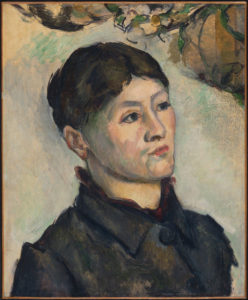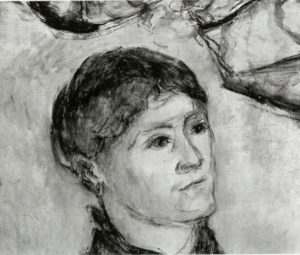R532 – Portrait de madame Cézanne, 1883-1885 (FWN468)
Pavel Machotka
(Cliquer sur l’image pour l’agrandir)
Having Mme Cézanne look up, in three-quarter view, Cézanne finds the angular lines and planes of her face. Here, in Portrait de Madame Cézanne, the burden of finding the right form is placed on an expressive and uniform outline (which, given its prominence over analytic surface, suggest a date of 1885 rather than earlier). The set of the sleeve at the shoulder, the frill of the blouse at the neck, the relaxed disorder of the hair, all become part of a decorative conception. So do the mysterious squiggles at the top, which, thanks to their abstract nature, seem all the more purely decorative. They are in fact painted over an area left over from a previous painting, and made to look like leaves; that at least makes their shape consistent with the forms of the figure, although it does not explain their presence. Whatever the original shape or sequence, the transformation of the top into a leafy surface, alive with the same rhythms as the figure, is what matters. Accepting the top as a pattern makes it easier to notice the other patterns: the correspondence between the splay in the parted hair and the splays in the leaves, between the frilly blouse and the squiggles in the leaves, and between the shape of the chin and the neckline. Cézanne has kept in mind a linear cohesion throughout, and it should be said that to achieve it he did not paint his wife thinner than usual, as has been suggested, but that the oval face simply presented a straighter cheek and thinner chin when the head was turned to a three-quarter view.
Source: Machotka, Cézanne: the Eye and the Mind.



